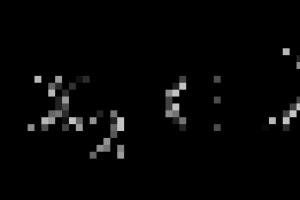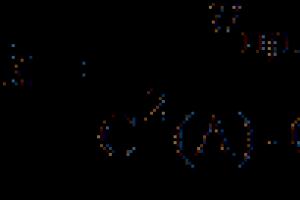Definition of an increasing function.
Function y=f(x) increases over the interval X, if for any and ![]() inequality holds. In other words, a larger argument value corresponds to a larger function value.
inequality holds. In other words, a larger argument value corresponds to a larger function value.
Definition of a decreasing function.
Function y=f(x) decreases on the interval X, if for any and ![]() inequality holds
inequality holds ![]() . In other words, a larger value of the argument corresponds to a smaller value of the function.
. In other words, a larger value of the argument corresponds to a smaller value of the function.

NOTE: if the function is defined and continuous at the ends of the increasing or decreasing interval (a;b), that is, when x=a And x=b, then these points are included in the interval of increasing or decreasing. This does not contradict the definitions of an increasing and decreasing function on the interval X.
For example, from the properties of basic elementary functions we know that y=sinx defined and continuous for all real values of the argument. Therefore, from the increase in the sine function on the interval, we can assert that it increases on the interval.
Extremum points, extrema of a function.
The point is called maximum point functions y=f(x), if for everyone x from its neighborhood the inequality is valid. The value of the function at the maximum point is called maximum of the function and denote .
The point is called minimum point functions y=f(x), if for everyone x from its neighborhood the inequality is valid. The value of the function at the minimum point is called minimum function and denote .
The neighborhood of a point is understood as the interval ![]() , where is a sufficiently small positive number.
, where is a sufficiently small positive number.
The minimum and maximum points are called extremum points, and the function values corresponding to the extremum points are called extrema of the function.

Do not confuse the extrema of a function with the largest and smallest values of the function.

In the first figure, the largest value of the function on the segment is reached at the maximum point and is equal to the maximum of the function, and in the second figure - the highest value of the function is achieved at the point x=b, which is not a maximum point.
Sufficient conditions for increasing and decreasing functions.
Based on sufficient conditions (signs) for the increase and decrease of a function, intervals of increase and decrease of the function are found.
Here are the formulations of the signs of increasing and decreasing functions on an interval:
if the derivative of the function y=f(x) positive for anyone x from the interval X, then the function increases by X;
if the derivative of the function y=f(x) negative for anyone x from the interval X, then the function decreases by X.
Thus, to determine the intervals of increase and decrease of a function, it is necessary:
Let's consider an example of finding the intervals of increasing and decreasing functions to explain the algorithm.
Example.
Find the intervals of increasing and decreasing functions.
Solution.
The first step is to find the definition of the function. In our example, the expression in the denominator should not go to zero, therefore, .
Let's move on to finding the derivative of the function: 
To determine the intervals of increase and decrease of a function based on a sufficient criterion, we solve inequalities on the domain of definition. Let's use a generalization of the interval method. The only real root of the numerator is x = 2, and the denominator goes to zero at x=0. These points divide the domain of definition into intervals in which the derivative of the function retains its sign. Let's mark these points on the number line. We conventionally denote by pluses and minuses the intervals at which the derivative is positive or negative. The arrows below schematically show the increase or decrease of the function on the corresponding interval. 
Thus,  And
And  .
.
At the point x=2 the function is defined and continuous, so it should be added to both the increasing and decreasing intervals. At the point x=0 the function is not defined, so we do not include this point in the required intervals.
We present a graph of the function to compare the results obtained with it.

Answer:
the function increases with ![]() , decreases on the interval (0;2]
.
, decreases on the interval (0;2]
.
Increasing and decreasing functions function y = f(x) is called increasing on the interval [ a, b], if for any pair of points X And X", a ≤ x the inequality holds f(x) ≤
f (x"), and strictly increasing - if the inequality f (x) f(x"). Decreasing and strictly decreasing functions are defined similarly. For example, the function at = X 2 (rice.
, a) strictly increases on the segment , and (rice.
, b) strictly decreases on this segment. Increasing functions are designated f (x), and decreasing f (x)↓. In order for a differentiable function f (x) was increasing on the segment [ A, b], it is necessary and sufficient that its derivative f"(x) was non-negative on [ A, b]. Along with the increase and decrease of a function on a segment, we consider the increase and decrease of a function at a point. Function at = f (x) is called increasing at the point x 0 if there is an interval (α, β) containing the point x 0, which for any point X from (α, β), x> x 0 , the inequality holds f (x 0) ≤
f (x), and for any point X from (α, β), x 0 , the inequality holds f (x) ≤ f (x 0). The strict increase of a function at the point is defined similarly x 0 . If f"(x 0) >
0, then the function f(x) strictly increases at the point x 0 . If f (x) increases at each point of the interval ( a, b), then it increases over this interval. S. B. Stechkin.
Great Soviet Encyclopedia. - M.: Soviet Encyclopedia. 1969-1978 .
See what “Increasing and decreasing functions” are in other dictionaries:
Concepts of mathematical analysis. The function f(x) is called the ratio of the numbers of different age groups of the population that increases on the segment AGE STRUCTURE OF THE POPULATION. Depends on birth and death rates, life expectancy of people... Big Encyclopedic Dictionary
Concepts of mathematical analysis. A function f(x) is said to be increasing on the segment if for any pair of points x1 and x2, a≤x1 ... encyclopedic Dictionary
Concepts of mathematics. analysis. Function f(x) is called. increasing on the segment [a, b], if for any pair of points x1 and x2, and<или=х1 <х<или=b, выполняется неравенство f(x1)
A branch of mathematics that studies derivatives and differentials of functions and their applications to the study of functions. Design of D. and. into an independent mathematical discipline is associated with the names of I. Newton and G. Leibniz (second half of 17 ... Great Soviet Encyclopedia
A branch of mathematics in which the concepts of derivative and differential and how they are applied to the study of functions are studied. Development of D. and. closely related to the development of integral calculus. Their content is also inseparable. Together they form the basis... ... Mathematical Encyclopedia
This term has other meanings, see function. The "Display" request is redirected here; see also other meanings... Wikipedia
Aristotle and the Peripatetics- Aristotle's Question Life of Aristotle Aristotle was born in 384/383. BC e. in Stagira, on the border with Macedonia. His father, named Nicomachus, was a physician in the service of the Macedonian king Amyntas, father of Philip. Together with his family, young Aristotle... ... Western philosophy from its origins to the present day
- (QCD), quantum field theory of the strong interaction of quarks and gluons, built in the image of quantum. electrodynamics (QED) based on “color” gauge symmetry. Unlike QED, fermions in QCD have complementary properties. quantum degree of freedom number,… … Physical encyclopedia
I Heart The heart (Latin cor, Greek cardia) is a hollow fibromuscular organ that, functioning as a pump, ensures the movement of blood in the circulatory system. Anatomy The heart is located in the anterior mediastinum (Mediastinum) in the Pericardium between... ... Medical encyclopedia
The life of a plant, like any other living organism, is a complex set of interrelated processes; The most significant of them, as is known, is the exchange of substances with the environment. The environment is the source from which... ... Biological encyclopedia
Very important information about the behavior of a function is provided by the increasing and decreasing intervals. Finding them is part of the process of examining the function and plotting the graph. In addition, the extreme points at which there is a change from increasing to decreasing or from decreasing to increasing are given special attention when finding the largest and smallest values of the function on a certain interval.
In this article we will give the necessary definitions, formulate a sufficient criterion for the increase and decrease of a function on an interval and sufficient conditions for the existence of an extremum, and apply this entire theory to solving examples and problems.
Page navigation.
Increasing and decreasing function on an interval.
Definition of an increasing function.
The function y=f(x) increases on the interval X if for any and ![]() inequality holds. In other words, a larger argument value corresponds to a larger function value.
inequality holds. In other words, a larger argument value corresponds to a larger function value.
Definition of a decreasing function.
The function y=f(x) decreases on the interval X if for any and ![]() inequality holds
inequality holds ![]() . In other words, a larger value of the argument corresponds to a smaller value of the function.
. In other words, a larger value of the argument corresponds to a smaller value of the function.

NOTE: if the function is defined and continuous at the ends of the increasing or decreasing interval (a;b), that is, at x=a and x=b, then these points are included in the increasing or decreasing interval. This does not contradict the definitions of an increasing and decreasing function on the interval X.
For example, from the properties of basic elementary functions we know that y=sinx is defined and continuous for all real values of the argument. Therefore, from the increase in the sine function on the interval, we can assert that it increases on the interval.
Extremum points, extrema of a function.
The point is called maximum point function y=f(x) if the inequality is true for all x in its neighborhood. The value of the function at the maximum point is called maximum of the function and denote .
The point is called minimum point function y=f(x) if the inequality is true for all x in its neighborhood. The value of the function at the minimum point is called minimum function and denote .
The neighborhood of a point is understood as the interval ![]() , where is a sufficiently small positive number.
, where is a sufficiently small positive number.
The minimum and maximum points are called extremum points, and the function values corresponding to the extremum points are called extrema of the function.

Do not confuse the extrema of a function with the largest and smallest values of the function.

In the first figure, the greatest value of the function on the segment is achieved at the maximum point and is equal to the maximum of the function, and in the second figure, the greatest value of the function is achieved at the point x=b, which is not the maximum point.
Sufficient conditions for increasing and decreasing functions.
Based on sufficient conditions (signs) for the increase and decrease of a function, intervals of increase and decrease of the function are found.
Here are the formulations of the signs of increasing and decreasing functions on an interval:
- if the derivative of the function y=f(x) is positive for any x from the interval X, then the function increases by X;
- if the derivative of the function y=f(x) is negative for any x from the interval X, then the function decreases on X.
Thus, to determine the intervals of increase and decrease of a function, it is necessary:
Let's consider an example of finding the intervals of increasing and decreasing functions to explain the algorithm.
Example.
Find the intervals of increasing and decreasing functions.
Solution.
The first step is to find the domain of definition of the function. In our example, the expression in the denominator should not go to zero, therefore, .
Let's move on to finding the derivative of the function: 
To determine the intervals of increase and decrease of a function based on a sufficient criterion, we solve inequalities on the domain of definition. Let's use a generalization of the interval method. The only real root of the numerator is x = 2, and the denominator goes to zero at x=0. These points divide the domain of definition into intervals in which the derivative of the function retains its sign. Let's mark these points on the number line. We conventionally denote by pluses and minuses the intervals at which the derivative is positive or negative. The arrows below schematically show the increase or decrease of the function on the corresponding interval. 
Thus,  And
And  .
.
At the point The x=2 function is defined and continuous, so it should be added to both the increasing and decreasing intervals. At the point x=0 the function is not defined, so we do not include this point in the required intervals.
We present a graph of the function to compare the results obtained with it.

Answer:
The function increases as ![]() , decreases on the interval (0;2] .
, decreases on the interval (0;2] .
Sufficient conditions for the extremum of a function.
To find the maxima and minima of a function, you can use any of the three signs of extremum, of course, if the function satisfies their conditions. The most common and convenient is the first of them.
The first sufficient condition for an extremum.
Let the function y=f(x) be differentiable in the -neighborhood of the point and continuous at the point itself.
In other words:
Algorithm for finding extremum points based on the first sign of extremum of a function.
- We find the domain of definition of the function.
- We find the derivative of the function on the domain of definition.
- We determine the zeros of the numerator, the zeros of the denominator of the derivative and the points of the domain of definition in which the derivative does not exist (all listed points are called points of possible extremum, passing through these points, the derivative can just change its sign).
- These points divide the domain of definition of the function into intervals in which the derivative retains its sign. We determine the signs of the derivative on each of the intervals (for example, by calculating the value of the derivative of a function at any point in a particular interval).
- We select points at which the function is continuous and, passing through which, the derivative changes sign - these are the extremum points.
There are too many words, let’s better look at a few examples of finding extremum points and extrema of a function using the first sufficient condition for the extremum of a function.
Example.
Find the extrema of the function.
Solution.
The domain of a function is the entire set of real numbers except x=2.
Finding the derivative: 
The zeros of the numerator are the points x=-1 and x=5, the denominator goes to zero at x=2. Mark these points on the number axis 
We determine the signs of the derivative at each interval; to do this, we calculate the value of the derivative at any of the points of each interval, for example, at the points x=-2, x=0, x=3 and x=6.
Therefore, on the interval the derivative is positive (in the figure we put a plus sign over this interval). Likewise 
Therefore, we put a minus above the second interval, a minus above the third, and a plus above the fourth.
It remains to select points at which the function is continuous and its derivative changes sign. These are the extremum points.
At the point x=-1 the function is continuous and the derivative changes sign from plus to minus, therefore, according to the first sign of extremum, x=-1 is the maximum point, the maximum of the function corresponds to it  .
.
At the point x=5 the function is continuous and the derivative changes sign from minus to plus, therefore, x=-1 is the minimum point, the minimum of the function corresponds to it  .
.
Graphic illustration.

Answer:
PLEASE NOTE: the first sufficient criterion for an extremum does not require differentiability of the function at the point itself.
Example.
Find extremum points and extrema of the function ![]() .
.
Solution.
The domain of a function is the entire set of real numbers. The function itself can be written as: 
Let's find the derivative of the function: 
At the point x=0 the derivative does not exist, since the values of the one-sided limits do not coincide when the argument tends to zero: 
At the same time, the original function is continuous at the point x=0 (see the section on studying the function for continuity): 
Let's find the value of the argument at which the derivative goes to zero: 
Let's mark all the obtained points on the number line and determine the sign of the derivative on each of the intervals. To do this, we calculate the values of the derivative at arbitrary points of each interval, for example, at x=-6, x=-4, x=-1, x=1, x=4, x=6.
That is, 
Thus, according to the first sign of an extremum, the minimum points are ![]() , the maximum points are
, the maximum points are ![]() .
.
We calculate the corresponding minima of the function 
We calculate the corresponding maxima of the function 
Graphic illustration.

Answer:
 .
.
The second sign of an extremum of a function.
As you can see, this sign of an extremum of a function requires the existence of a derivative at least to the second order at the point.
Currently, there is a contradiction between the need of high school students to demonstrate creativity, activity, independence, self-realization and the limited time for this in mathematics lessons. Since 2006, I have been using textbooks “Algebra 7, 8, 9” with an in-depth study of mathematics by Yu. N. Makarychev, N. G. Mindyuk, K. I. Neshkov for students in mathematics classes in order to make an informed choice by students of the educational profile, providing students have the opportunity to work at a level of increased mathematical requirements, developing their learning motivation.
How to include students in independent research activities so that they themselves “discover” new properties and relationships, and do not receive them from the teacher in a ready-made form? Many years of work experience and the desire to change traditional ideas about teaching pushed me to use research activities in my mathematics lessons. Of course, changing the method of work, the structure of the lesson and taking on the function of an organizer of the learning process, a function that ensures the systematic inclusion of each student, regardless of intellectual level, in basic activities, required me to have certain knowledge and readiness for self-development.
I think that the student’s involvement in activities affects both the depth and strength of their knowledge acquisition, and the formation of his value system, that is, self-education. Students' ability for self-development and self-education will allow them to successfully adapt to constantly changing external conditions without coming into conflict with society.
Section topic:"Properties of functions".
Lesson topic:"Increasing and decreasing functions."
Lesson type: a lesson in studying and initially applying new material.
Basic goals:
- To promote the formation in students of a new concept of a monotonic function;
- Cultivate a positive attitude towards knowledge, the ability to work in pairs;
- To promote the development of analytical thinking, skills of partial search cognitive activity.
DURING THE CLASSES
I. Updating of reference knowledge
– Define the function.
– What formula defines the functions whose graphs are shown in the drawing. (Appendix 2)
II. Formation of new knowledge
- Function f(x) is called increasing on the set X if for any two values of the argument X 1 and X 2 sets X such that X 2 > X f(x 2 ) > f(x 1 ) .
- Function (X) is called decreasing on the set X if for any two values of the argument X 1 and X 2 sets X such that X 2 > X 1, the inequality holds f(x 2 ) <f(x 1 ) .
- A function that increases on a set X or decreases on a set X is called monotone on the set X.
Let's find out the nature of monotonicity of some types of functions: (Appendix 4)
Function f(x)= – increasing. Let's prove it.
The expression makes sense only when X >
0. Therefore D (f)= . For odd n the function f(x) = x n increases over the entire domain of definition, that is, over the interval (– ; +). (Appendix 7)
Inverse proportionality, that is, the function f(x)= in each of the intervals (– ; 0) and (0; + ) at k> 0 decreases, and when k < 0 возрастает.
(Приложение 8)
Let's consider some properties of monotonic functions (Appendix 9):
IV. Formation of practical skills
Here are examples of using the properties of monotonic functions:
Let's find out at how many points the straight line at= 9 intersects the graph of the function f(x) = + + .
Solution:
Functions at= , у = and у = are increasing functions (property 4). The sum of increasing functions is an increasing function (property 3). And an increasing function takes each of its values only for one argument value (property 1). Therefore, if the straight line y = 9 has common points with the graph of the function f(x)= + + , then only one point.
By selection one can find that f(x)= 9 at X= 3. So it’s straight at= 9 intersects the graph of the function f(x)= + + at point M(3; 9).
Let's solve the equation X 3 – + = 0.
Solution:
It's easy to see that X= 1 – root of the equation. Let us show that this equation has no other roots. Indeed, the domain of definition of the function y = x 3 – + – set of positive numbers. On this set the function increases, since each of the functions at = X 3 , at= – and at= increases on the interval (0; +). Therefore, this equation has roots other than X= 1, does not have.








